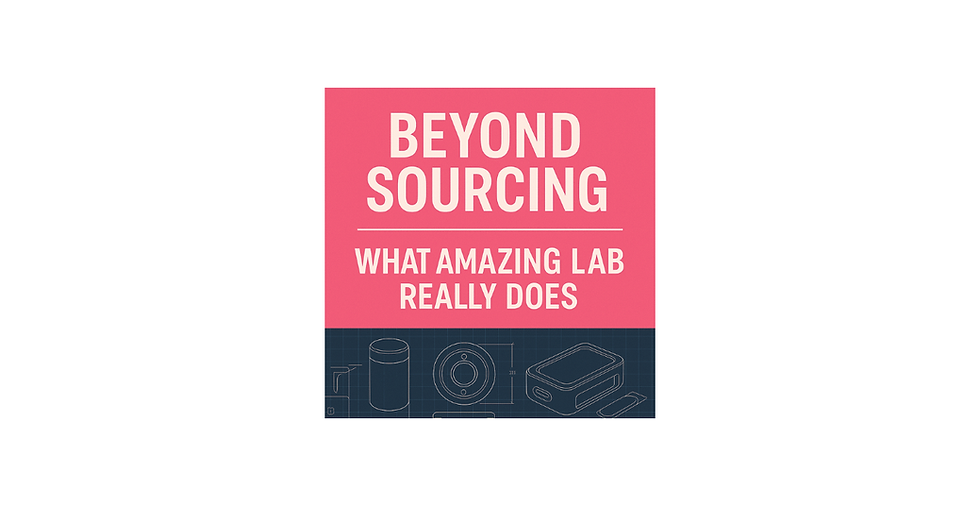From Prototypes to Products: Why Hybrid Tooling Works for Wellness Startups
- Ami Sin

- May 2
- 3 min read
Updated: May 5
In wellness and personal care, no two customers are exactly alike. From skin types to supplement needs to fitness goals, personalization is no longer a luxury—it’s an expectation. But if you're a founder trying to launch a customized product, you’ve probably run into a major roadblock: traditional manufacturing just isn't built for flexibility.
That’s where hybrid tooling comes in.
What Is Hybrid Tooling?
Hybrid tooling combines multiple manufacturing methods—like 3D printing, CNC machining, soft molds, and traditional tooling—into a smart, staged process. Instead of locking into one approach too early, hybrid tooling lets you:
Launch faster – Iterate prototypes and test early runs without waiting for steel molds.
Customize efficiently – Create personalized features or modular add-ons using 3D printing.
Scale wisely – Shift to traditional tooling only when volume and design are stable.
Personalization Demands Flexibility
Let’s say you’re designing a supplement pod that delivers a tailored mix for each user, or a skincare tool that needs to fit different face shapes. You don’t want to invest in hard tooling for a design that might need 10 more tweaks.
3D printing allows you to test these personalized components quickly, with real users. And over time, as patterns emerge, you can shift standard parts—like enclosures or caps—to traditional tooling, while still 3D printing the personalized inserts or accessories.
In fact, many wellness products now never move fully to traditional tooling. They mix methods:
A tooled base unit that’s mass-produced
Interchangeable 3D printed parts for customization
Soft tooling for packaging that changes seasonally
It’s smart manufacturing for a smart market.
Wearables Are a Natural Fit
Wearables—like posture trainers, sleep sensors, fitness bands, or menstrual health devices—must adapt to the body and often require ergonomic fine-tuning. With hybrid tooling, you can:
Rapidly prototype and test fit/comfort across body types
Use 3D printing for small-batch production of straps, clips, or enclosures
Tool only the core structural components once the design is validated
This approach keeps your design user-centered, especially when comfort and daily use are key.
Why I Always Think Hybrid
As someone with both a manufacturing background and a business brain, I always look at cost, time, and quantity before choosing the most suitable production method. Thanks to years of reviewing P&L statements (and sometimes living in spreadsheets!), I know how fast early decisions can snowball into sunk costs and delays.
That’s why I’m such a believer in hybrid tooling: it gives founders room to breathe, test, and evolve—without blowing the budget before you even reach your first customer.
Case in Point: Smarter Tooling for a Smart Garden
One of our recent projects involved an indoor hydroponic herb garden system. The startup founders had a solid product idea and early traction, but when they sent the design to a traditional OEM manufacturer, the quote came back with an eye-watering $170,000 tooling cost, covering 12 molds for just 15 plastic parts.
We stepped in to conduct a hybrid tooling analysis. After reviewing the product’s cosmetic and functional requirements, part sizes, and target quantities, we reorganized the components into two strategic groups:
Larger or more visible parts that require traditional tooling for durability and finish
Smaller, lower-volume or internal components where 3D printing made more sense
By factoring in the size of each part, we also reduced the overall mold complexity and cost, since some bulky parts that didn’t require high cosmetic detail were shifted to additive manufacturing.
We collaborated closely with the startup team on both the product development and the go-to-market plan. In the end, we delivered a custom strategy that cut their initial tooling investment by 30%, allowing them to move forward with a small batch for user testing and investor presentations, without overcommitting too early. This kind of flexibility is exactly what hybrid tooling unlocks.
Don’t Let Manufacturing Limit Your Vision
If you’re building a personalized wellness or wearable product, you need a manufacturing strategy as agile as your design. Hybrid tooling lets you experiment early, refine often, and scale when the time is right. It’s not just about saving money—it’s about meeting your customer’s needs faster and better.
by Ami Sin, Founder Amazing Lab


Comments